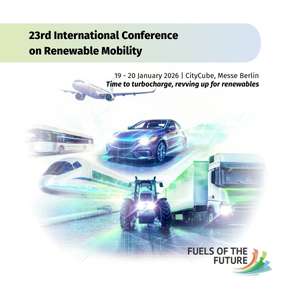B10: Europe’s overlooked climate solution

Every year spent waiting for future solutions locks in millions of tonnes of greenhouse gases (GHGs) unnecessarily. And the wait has been considerable; nine years ago, the European Commission announced a strong push towards having more zero-emission vehicles in our fleet.
What the EU needs now are pragmatic, scalable tools to cut emissions today.
One answer to help this situation is B10 diesel.
This 10% biodiesel blend offers an immediate, proven path to lower transport GHG emissions. It requires no changes to engines, no new infrastructure, and no technological leaps. The production capacity is here. The vehicles are ready.
The only obstacle is political inertia—and the continued allowance of B7 as the principal standard, which unfortunately discourages retailers from offering B10.
It’s time for a course correction.
Europe must treat B10 as a critical stepping stone to meeting climate targets and increasing the GHG savings from liquid fuels in the energy transition.
A proven solution hidden in plain sight
Under the current EN590 diesel standard, only 7% biodiesel (B7) is permitted. Raising this limit to 10% (B10) may sound incremental, but it represents a 43% increase in renewable content along with an equivalent greater reduction in GHG reductions per litre of diesel. For a continent still dependent on diesel for freight, public transport, and agriculture, this is a climate policy lever with unmatched immediacy.
Unlike future fuels dependent on unbuilt infrastructure or scarce raw materials, B10 is already a reality. Europe’s waste-based and advanced biodiesel industry has the capacity to supply B10 continent-wide without encroaching on food supplies or biodiversity.
FAME biodiesel has provided Europe with it’s largest share of GHG savings in transport for many years.
The recent Bente Project, led by Coburg University in partnership with AGQM and Volkswagen, demonstrated B10’s technical readiness under rigorous laboratory and real-world tests. Euro 6d diesel vehicles fueled with B10 matched or outperformed B7 and fossil diesel across urban, highway, and lab-based WLTC cycles.
Emissions of NOx, hydrocarbons, carbon monoxide, and particulate matter remained comfortably within Euro 6 limits.
In some instances, B10 even delivered lower NOx and CO2 emissions than B7.
Concerns around oil dilution in urban stop-start driving were addressed in the trials, showing no adverse effects. Long-haul testing confirmed acceptable oil aging and viscosity levels, dispelling myths about B10’s suitability for modern diesel engines.
AGQM’s oversight ensured fuel quality and stability, with B10 demonstrating excellent oxidation resistance and thermal aging performance—even under stress conditions.
In short, B10 is a tested, certified, and scalable solution ready for immediate deployment.
Lessons from early movers: France, Portugal and beyond
The EU need not reinvent the wheel. France already made B10 its standard diesel blend years ago, with seamless integration across its fueling network. Portuguese consumers have access to B15 at over 165 stations with excellent operational performance noted. Beyond Europe for example, U.S. truck stops routinely offer diesel blends ranging from B6 to B20 under a unified labeling system, allowing retailers flexibility while avoiding consumer confusion.
Vehicle manufacturers are also on board. Many OEMs now specifically approve B10 use in their diesel models, supported by the existing EN 16734 technical standard. Importantly, B10 doesn’t compete with other renewable diesel options like HVO.
On the contrary, combining HVO with B10 or even B20/B30 blends opens the door for higher renewable shares in diesel, especially for captive fleets or sectors with heavy-duty requirements.
Yet despite these obvious success stories, most EU fuel stations still offer only B7.
The reason is structural: fuel retailers face no incentive to switch. Even though B10 is now the new default standard following the 2023 update to the Fuel Quality Directive (FQD), commercial realities make fuel retailers hesitant to transition.
The cost of switching, lingering uncertainty among a few OEMs, and lack of customer acknowledgement about B10’s benefits combine to discourage widespread adoption. Without stronger policy signals, retailers are unlikely to allocate resources or limited pump space to promote B10 over B7. As long as B7 remains legally permissible under the FQD and in EN590, the widespread introduction of B10 will continue to stall.
Removing the roadblocks: A call for political courage
EWABA urges European and national policymakers to break this deadlock. The technical groundwork is done. Vehicles are compatible. Infrastructure is ready. Supply is secure. The missing ingredient is political will.
Specifically, policymakers should:
• Align the EN590 diesel standard with the Fuel Quality Directive by permitting B10 as the standard diesel blend across the EU.
• Incentivise fuel retailers to replace B7 with B10 at all forecourts, ensuring uniform availability.
• Encourage OEM approvals for B10 in all applicable diesel vehicles.
• Align public procurement for municipal and national fleets to favour B10-compatible fuels.
Keeping B7 on the market actively discourages retailers from adopting B10.
Fuel pump space is finite, and operators are unlikely to dedicate capacity to higher biodiesel blends as long as B7 satisfies the minimum legal requirement.
Phasing out B7 as the standard is essential to unlock B10’s full potential.
These measures are low-cost yet highly effective, delivering instant GHG reductions without waiting for next-generation technologies.
Conclusion: B10 Is Europe’s shortcut to better climate credibility
The EU’s climate targets are non-negotiable, but the path to achieving them is anything but assured. While electrification gathers pace, liquid fuels will remain vital for decades. B10 offers a pragmatic, scalable bridge—one that cuts emissions today and buys precious time for the broader energy transition.
Europe has the tools, the capacity, and the expertise to act.
Consumers won’t feel the difference at the pump, but the environment will.
With B10, the EU can turn climate ambition into immediate, measurable action and set a global benchmark for pragmatic policymaking.
The EU cannot afford to let procedural delays undermine climate progress. It’s time to implement B10 without further hesitation.
By Adrian O’Connell, Technical Affairs Expert at European Waste-based & Advanced Biodiesel Association (EWABA)












